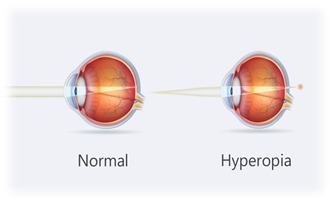
There are three main types of hyperopia. The simple type, also known as astigmatism, occurs due to refractive or axial errors. Pathological hyperopia is the result of ocular abnormalities, diseases, or trauma. Functional hyperopia is caused by a paralysis of accommodation. A patient with high hyperopia has a focusing error of approximately +2 D. While facultative and absolute forms of the condition can be corrected by accommodation, they can't.
The first type is called farsightedness, while the second is known as hyperopia. It results from a reduction in the eyeball's size, which is responsible for the reduced size of the retina. Children with hyperopia often experience headaches and difficulty working up close. Affected children should undergo regular optical examinations, especially if they have a family history of vision problems. For severe cases of hyperopia, surgery is the only option.
Both forms of hyperopia can be treated. The most common treatment for this condition is glasses or contacts. In some cases, corrective surgery is necessary. This is the recommended option for most patients. In some cases, hyperopia can be corrected with a contact lens. However, there is no cure for this condition, so the first step in treating it is to find a specialist. Once you've been diagnosed, you can work towards an appropriate treatment plan.
People with both types of farsightedness should consider corrective glasses and sunglasses. Although both types of farsightedness are common, there are many treatments available for each. Some people suffering from these problems may wear glasses to improve their vision. To prevent progression of the disease, it is important to avoid prolonged exposure to ultraviolet rays. In addition, regular eye examinations are important for patients with farsightedness as well as for their family members.
If the condition does not correct, patients should undergo slit lamp examination. This test can determine whether a person is farsighted or farsighted. The results will help your doctor diagnose the specific cause of farsightedness. There are several causes of farsightedness. Most patients with farsightedness experience frequent headaches when performing close work. Some cannot see clearly. If your vision is not normal, you should consult a doctor immediately.

Refractive errors are caused by a lack of focus. A person suffering from hyperopia may experience blurred vision when looking at objects with a magnifying glass. Optical correction is the best way to improve hyperopia. A doctor will prescribe a lens for each of the three types of eye problems. In some cases, prescription lenses are necessary. When you don't have vision problems, contact your eye doctor immediately to receive an examination.
When a patient has a farsighted eye, the image that they see is blurry. They may experience headaches when working close to objects. This condition can lead to other issues, such as a reduced eyeball size. Fortunately, this defect will usually resolve itself with age. But, for some people, it can cause significant problems. A farsighted person may have a headache when reading, and a hyperope might experience it more often when looking at things that are too close.
In some cases, the person with low levels of hyperopia will not notice a problem at a distance, but may have problems seeing things close to their eyes. If their hyperopia is moderate, they will notice a blurry vision at a distance. If their eyesight is severe, they will need glasses all the time and may spend more time working up close. These people may have a more noticeable headache than other people. A basic eye examination can help detect the condition.
Other hyperopia types are inherited. Most babies are farsighted, and eventually outgrow the condition. As they get older, their eyes will become more capable of focusing a distant object on a nearby object. This type of hyperopia causes an eye to have a narrow angle, which can lead to severe problems. This type of eye problem can cause headaches and affect people's daily activities. So, it's important to seek treatment as soon as you notice a problem.
There are two main hyperopia types. The extremes of the condition are characterized by near and farsightedness. This is the most common one, which is associated with glaucoma. The sensitivity of the lens, which is responsible for focusing objects, is reduced in people with this type of eye disorder. As a result, the person has to wear glasses or contact lenses to correct their vision. The other type of hyperopia is known as strabismus.
